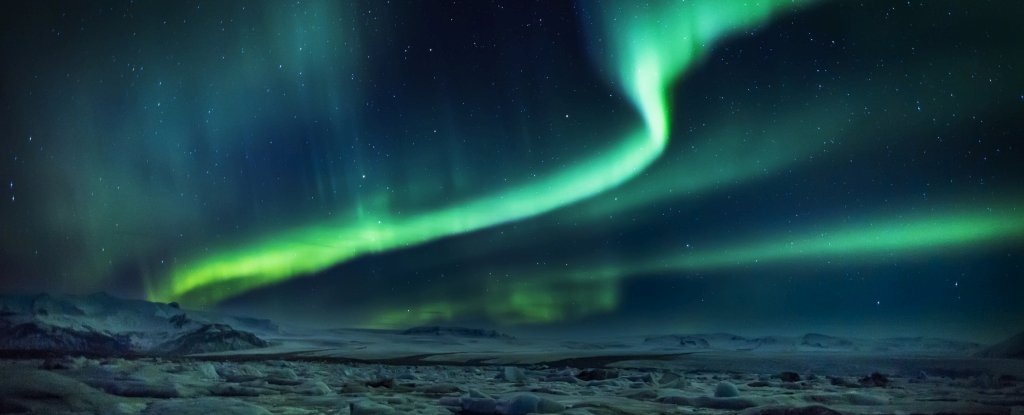
A global turmoil 42,000 years ago was the result of a reversal in Earth’s magnetic field, new research shows.
According to radiocarbon preserved in ancient tree rings, several centuries of climate degradation, mass extinctions and even changes in human behavior can be directly linked to the last time the Earth’s magnetic field changed polarity.
The research team has dubbed the period the Adams Transitional Geomagnetic Event, or Adams Event, after sci-fi writer Douglas Adams, who called the number 42 the ultimate answer to life, the universe, and everything.
“For the first time ever, we have been able to precisely date the timing and environmental impact of the last magnetic pole switch,” said earth scientist Chris Turney of the University of New South Wales in Australia.
“The findings were made possible with ancient New Zealand kauri trees, which have been preserved in sediments for over 40,000 years. Using the old trees, we were able to measure and date the peak in atmospheric radiocarbon levels caused by the Earth’s magnetic collapse. field. “
This most recent period of magnetic reversal is known as the Laschamp event, and it is what we call a geomagnetic excursion. This is when the planet’s magnetic poles briefly switch places before returning to their original positions. It is one of the most studied magnetic field events on Earth, recorded by ferromagnetic minerals.
It took place about 41,000 years ago and lasted about 800 years. Exactly what impact this event had on life on the planet was unclear – so when scientists discovered an ancient kauri tree (Agathis australis) in 2019 who lived during this period, they seized the opportunity to learn more.
That’s because trees register atmospheric activity in their annual rings. Carbon-14, or radiocarbon, in particular, can reveal a lot of information about celestial activity.
Radiocarbon only occurs on Earth in trace amounts compared to the other naturally occurring carbon isotopes. It was formed in the upper atmosphere under the bombardment of cosmic rays from space. When these rays enter the atmosphere, they work with the local nitrogen atoms to initiate a nuclear reaction that produces radiocarbon.
Since cosmic rays are constantly flowing through space, the Earth receives a more or less constant supply of radiocarbon. Therefore, a spike in radiocarbon in tree rings tells us that the Earth had greater radiocarbon exposure that year.
When Earth’s magnetic field is weakened, as it was during the Laschamp event, more cosmic rays penetrate into the atmosphere to produce more radiocarbon. Therefore, scientists could have previously determined that Earth’s magnetic field had weakened to about 28 percent of its normal strength over that 800-year period.
The kauri tree allowed the research team to study the years leading up to the Laschamp event. They found that the Adams event happened about 42,200 years ago and that the magnetic field was at its weakest point before the Laschamp event.
“Earth’s magnetic field dropped to just 0-6 percent during the Adams Event,” explained Turney. “We basically had no magnetic field at all – our cosmic ray shield was completely gone.”
During this time, the sun’s magnetic field would also have weakened several times as it was also experiencing a magnetic reversal as part of its normal cycle. During these periods there is less activity from sunspots and flares, but the sun’s magnetic field also provides the Earth with some degree of protection from cosmic rays – so during these minima of the sun, the bombardment of cosmic rays would have increased again.
This weakened magnetic field is said to have led to significant changes in Earth’s atmospheric ozone, with dramatic consequences, including electrical storms and spectacular aurorae, and climate change around the world.
“Unfiltered radiation from space tore apart air particles in Earth’s atmosphere, separating electrons and radiating light – a process called ionization,” said Turney.
“The ionized air ‘baked’ the ozone layer, causing a wave of climate change around the world.”
This is consistent with contemporary climate and environmental changes observed in other records from around the world, such as the mysterious extinction of the megafauna in Australia.
Curiously, it also coincides with some of our oldest cave art ever recorded, leading the researchers to hypothesize that the Adams event could have drove people in.
“This sudden change in behavior in very different parts of the world is consistent with increased or altered use of caves during the Adams Event, possibly as a shelter from the rise of ultraviolet B, possibly to harmful levels, during grandsolar minima or solar energetic particles,” which could also explain increased use of red ocher sunscreen, ”they wrote in their paper.
That is somewhat speculative, of course, but it suggests that a geomagnetic reversal could be a serious world-changing event. And recent evidence suggests that we are currently on the brink of another.
This, the researchers say, could be absolutely disastrous in the current climate.
“Our atmosphere is already filled with carbon at levels never seen by humanity. A magnetic polar reversal or extreme change in the activity of the sun would be unprecedented accelerators of climate change,” said Turney.
“We urgently need to reduce CO2 emissions before such a random event happens again.”
The research is published in Science